Do you have a question about the Yamaha KODIAK 450 and is the answer not in the manual?
Key safety advice for operating the ATV, emphasizing reading the manual and paying attention to labels.
Indicates a potential hazard that could result in severe injury or death to the operator or bystanders.
Check operation, fluid level, and leakage. Fill with DOT 4 fluid if necessary.
Check operation, fluid level, and leakage. Fill with DOT 4 fluid if necessary.
Check coolant level and fill with coolant if necessary.
Check for leakage.
Check for proper throttle cable operation and free play.
Check tire pressure, wear, and damage.
Check for free play, operation, and smooth movement of levers and pedal.
Check brake fluid level and replenish as necessary.
Check for leaks in brake fluid lines and reservoirs.
Test brakes at slow speed to ensure proper performance.
Step-by-step procedure for starting the engine in cold weather conditions.
Warning about the risks of operating the ATV without understanding its controls.
Warning about the risk of unable to control the ATV due to frozen control cables.
Procedure for starting the engine when it is already warm, referring to cold start section.
Guidelines for carrying cargo and towing trailers, including weight limits.
Encourages training for new operators and familiarization with the ATV at slow speeds.
Emphasizes wearing proper safety gear like helmets, eye protection, gloves, and protective clothing.
Highlights the risk of accidents or damage from not performing pre-operation checks.
Warns about the loss of control and increased accident risk from improper tires or tire pressure.
Advises keeping feet on footboards to avoid contact with rear wheels and maintain control.
Warns that riding on paved surfaces can cause loss of control as ATVs are designed for off-road use.
States that riding on public roads is illegal and can result in collisions with other vehicles.
Emphasizes caution on unfamiliar terrain to avoid accidents from hidden hazards like rocks or bumps.
Advises caution on rough, slippery, or loose terrain to maintain traction and control.
Explains the risks of improper turning and the need for practice at low speeds.
Warns about the increased risk of overturns on steep hills and advises practicing on smaller inclines.
Details risks of climbing hills improperly, including loss of control and overturns.
Provides procedures for handling stalls or rolling backwards on hills to prevent overturns.
Outlines risks of going downhill improperly, including loss of control and overturns.
Risks of improper hill crossing or turning, potentially leading to loss of control or overturns.
Warns against operating in deep or fast water due to floatation and loss of control risks.
Details risks of operating over obstacles, including loss of control and overturns.
Advises practicing controlled sliding and caution on slippery surfaces to avoid loss of control.
Warning about the dangers of moving parts and electrical components when the engine is running.
Replace engine oil, warming the engine before draining.
Detailed procedure for changing the engine oil and replacing the oil filter.
Diagnostic charts for starting issues and poor engine performance.
Recommended fuel type, tank capacity, and reserve amount.
Key safety advice for operating the ATV, emphasizing reading the manual and paying attention to labels.
Indicates a potential hazard that could result in severe injury or death to the operator or bystanders.
Check operation, fluid level, and leakage. Fill with DOT 4 fluid if necessary.
Check operation, fluid level, and leakage. Fill with DOT 4 fluid if necessary.
Check coolant level and fill with coolant if necessary.
Check for leakage.
Check for proper throttle cable operation and free play.
Check tire pressure, wear, and damage.
Check for free play, operation, and smooth movement of levers and pedal.
Check brake fluid level and replenish as necessary.
Check for leaks in brake fluid lines and reservoirs.
Test brakes at slow speed to ensure proper performance.
Step-by-step procedure for starting the engine in cold weather conditions.
Warning about the risks of operating the ATV without understanding its controls.
Warning about the risk of unable to control the ATV due to frozen control cables.
Procedure for starting the engine when it is already warm, referring to cold start section.
Guidelines for carrying cargo and towing trailers, including weight limits.
Encourages training for new operators and familiarization with the ATV at slow speeds.
Emphasizes wearing proper safety gear like helmets, eye protection, gloves, and protective clothing.
Highlights the risk of accidents or damage from not performing pre-operation checks.
Warns about the loss of control and increased accident risk from improper tires or tire pressure.
Advises keeping feet on footboards to avoid contact with rear wheels and maintain control.
Warns that riding on paved surfaces can cause loss of control as ATVs are designed for off-road use.
States that riding on public roads is illegal and can result in collisions with other vehicles.
Emphasizes caution on unfamiliar terrain to avoid accidents from hidden hazards like rocks or bumps.
Advises caution on rough, slippery, or loose terrain to maintain traction and control.
Explains the risks of improper turning and the need for practice at low speeds.
Warns about the increased risk of overturns on steep hills and advises practicing on smaller inclines.
Details risks of climbing hills improperly, including loss of control and overturns.
Provides procedures for handling stalls or rolling backwards on hills to prevent overturns.
Outlines risks of going downhill improperly, including loss of control and overturns.
Risks of improper hill crossing or turning, potentially leading to loss of control or overturns.
Warns against operating in deep or fast water due to floatation and loss of control risks.
Details risks of operating over obstacles, including loss of control and overturns.
Advises practicing controlled sliding and caution on slippery surfaces to avoid loss of control.
Warning about the dangers of moving parts and electrical components when the engine is running.
Replace engine oil, warming the engine before draining.
Detailed procedure for changing the engine oil and replacing the oil filter.
Diagnostic charts for starting issues and poor engine performance.
Recommended fuel type, tank capacity, and reserve amount.
| Brand | Yamaha |
|---|---|
| Model | KODIAK 450 |
| Category | Offroad Vehicle |
| Language | English |
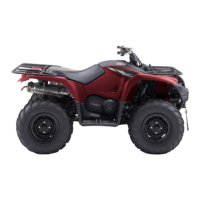

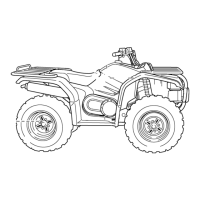
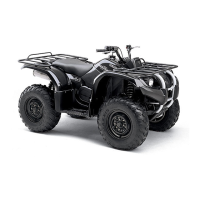

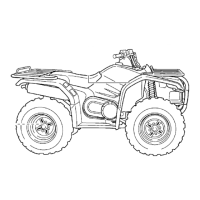
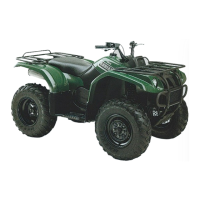

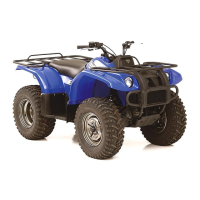
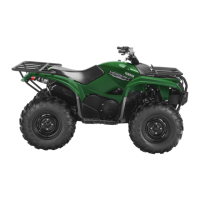

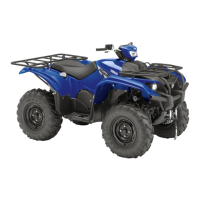
